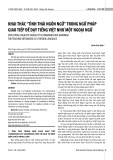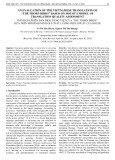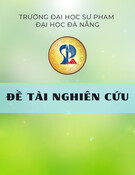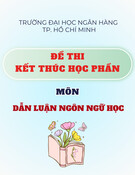
78 TRƯỜNG ĐẠI HỌC THỦ ĐÔ HÀ NỘI
IDIOMS AND PROVERBS RELATED TO RELATIONSHIPS
IN ENGLISH AND VIETNAMESE - A CONTRASTIVE
ANALYSIS RESEARCH ISSUES
Hoang Thi Thanh Ha - Nguyen Thi Van Anh
Faculty of Foreign Languages - Hanoi Metropolitan University
Abstract: English has undoubtedly become one of the most extensively used languages in
the world. The trend of learning English has demonstrated to learners that concentration
is necessary for efficient language use. Comprehending and effectively utilizing English or
Vietnamese idioms and proverbs not only enhances learners' self-assurance in
communication but also broadens their comprehension of both Western and Eastern
cultures. This allows them to develop a communication style and cultural background that
are suitable for their home language. Both Eastern and Western cultures frequently
employ proverbs and idioms. This article is focused on some similarities as well as
differences of the idioms and proverbs between English and Vietnamese. Consequently, to
assist close the multicultural divide and establish efficient communication, learners utilize
idioms and proverbs linked to relationships in both languages.
Keywords: Features; idioms; proverbs; relationships; semantics.
Nhận bài ngày 10.01.2024; gửi phản biện, chỉnh sửa và duyệt đăng ngày 28.04.2024
Liên hệ tác giả: Nguyễn Thị Vân Anh; Email: ntvanh@daihocthudo.edu.vn
1. INTRODUCTION
Given the present globalization trend, English has undoubtedly become one of the most
commonly used and well-liked languages globally. English is becoming more and more
popular as a language to learn as it has long been considered a global communication tool.
Idioms are a distinctive means of conveying ideas that can be either literal or metaphorical.
Every nation on the planet has its unique colloquialisms. Some of them are distinctive and
represent the national culture in that particular area. Conversely, idioms often have
numerous meanings in different languages, highlighting the necessity of defying cultural
norms and customs worldwide. Acquiring mastery over idioms may instill confidence in
learners and facilitate effective communication with speakers of other languages. Idioms
can also help pupils adjust to the habits and traditions of other nations or cultures.
Numerous research has been done on proverbs and idioms in a variety of settings, for a
variety of purposes, and from a variety of viewpoints. On the other hand, no study has been
done on the semantic characteristics of relationship-related proverbs and Vietnamese and
English idioms.

TẠP CHÍ KHOA HỌC - SỐ 83/THÁNG 4 (2024) 79
The purpose of the research is to add new perspectives to the English and Vietnamese
idioms and proverbs about relationships. This study, in particular, compares the semantic
features of proverbs and idioms associated with relationships in Vietnamese and English.
By using techniques like data research methodologies, analytical research, and
gathering, this report was created. Sources searched through literary works about
Vietnamese idioms and proverbs such as "Thành ngữ Việt Nam" by Nguyen Luc [1] or “Từ
điển Tiếng Việt” by Hoang Phe [2]. In terms of English references, there are literary and
artistic works by Tom Topor, Sam McBratney, etc. This research is carried out in the
following steps:
Step 1: Read and refer to documents: previous research studies and documents related
to idioms and proverbs.
Step 2: Select and collect important data for research.
Step 3: Analyze, compare, and contrast the semantic characteristics of the selected
pairs of proverbs and idioms.
Step 4: Give results, synthesize, and conclude.
2. RESEARCH CONTENT
2.1. A theoretical to idioms and proverbs related to relationships in English and
Vietnamese
2.1.1. Idioms
An idiom is defined as "an expression which functions as a single unit and whose
meaning cannot be worked out from its separate parts" by the Longman Dictionary of
Language Teaching and Applied Linguistics [3]. The definition of an idiom in the
Cambridge International Dictionary of Idioms [4] is “a group of words in a fixed order that
has a particular meaning that is different from the meanings of each word on its own”.
Generally speaking, idioms have a deeper meaning than non-idiomatic expressions. For
example, "letting the cat out of the bag" conveys a more striking message than accidentally
revealing a secret. Additionally, idioms can convey the user's mood, such as approbation,
amusement, annoyance, or admiration.
According to “Từ điển Tiếng Việt” [2], idiom is defined as “Thành ngữ là một tập hp
từ đã quen dùng mà ngha thưng không gii thích đươc một cch đơn gin bằng ngha
thưng của các từ to nên nó”.
Idioms often employ fixed language; grammatically speaking, they are merely words or
phrases because they are not whole sentences, according to Nguyen Luc in “Thành ngữ
Tiếng Việt” [1]. Idioms typically serve a figurative rather than an instructional purpose
since they don't provide any commentary, life lessons, moral lessons, or criticism. As an
illustration, the idiom “Beauty is only skin deep” or in Vietnamese, it is said “Tốt gỗ hơn tốt
nước sơn. Xấu ngưi đẹp nết cn hơn đẹp ngưi” to point out that the quality of the inside
is always more important and valuable than the external beauty. The term "beauty" refers to
attributes that are considered admirable and deserving in life, such as intelligence, people
skills, and a pleasant disposition. Additionally, "Skin deep" focuses on the word "deep,"

80 TRƯỜNG ĐẠI HỌC THỦ ĐÔ HÀ NỘI
which is difficult to view clearly and immediately; instead, one must attempt to uncover it
layer by layer. "Skin deep" takes on a mysterious and unique quality in this expression. The
phrase features the word "only" in addition to its two primary, intriguing components. It
makes sense that the word "only" would denote anything being the best, unique, and
valuable version of something that exists in life. Placing the term "skin deep" in front of it
highlights the variations in internal values and seems to be teaching the reader to respect
personality above looks.
As the people said, idioms have a lot of features. An idiom is a phrase consisting of
several words, often inflected to create a figurative meaning. It functions as a cohesive
semantic unit, equivalent to a literal synonym. It is resistant to interruption by other words
and can't be rearranged. Typically, "break a leg" means good luck but cannot be changed to
"break legs" or "break the left leg".
Its syntactic structure is unproductive, as a lexeme can only collocate once in an
idiomatic formulation. The expression's idiomatic meaning is lost if other words from the
same generic lexical relation set are substituted. For instance, "pull someone's leg" cannot
be changed into "pull someone's feet" or "pull someone's ears". Lastly, an idiom has an
abnormal syntactic structure, with a peculiar grammatical structure. For example, "That's
small potatoes" means to say something is not important or unnecessary, but uses the plural
form instead of "potato." These characteristics make an idiom unique and essential in
language.
2.1.2. Proverbs
Proverbs are used by speakers to express ideas, give perspective weight in debates, and
enliven a subject or conversation. They can be used to subtly express ideas, invoke
ancestors' customs, or simply enliven a subject or conversation. In many regions, using
proverbs in speech is considered a sign of a skilled orator.
In theory, there are numerous approaches to defining what constitutes a proverb.
According to Wolfgang Mieder “A proverb is a short, generally known sentence of the folk
which contains wisdom, truth, morals, and traditional views in a metaphorical, fixed and
memorizable form and which is handed down from generation to generation” [5]. Proverbs
are "Folk wisdom" that provides general guidance on behavior and life, often reflecting the
cultural values and natural surroundings from which they originate. Examples include
proverbs about the sea in Hawaiian cultures, elephants in Eastern cultures, and American
proverbs about hard work for success. Proverbs are used to support claims, offer teachings,
and emphasize common ideals.
However, Vietnamese proverbs have slightly different meaning. Proverbs are described
as "short statements, often expressed with rhythm, which sum up knowledge, life
experience, and moral lessons of people" in "Từ điển Tiếng Việt” [2].
Proverbs, like idioms, have remained unchanged throughout history and are often
interpreted metaphorically. For instance, "The pen is mightier than the sword" suggests that
written words can yield more than force or action. Proverbs also use grammatical and
theoretical strategies like alliteration, rhyme, parallel construction, repetition of important

TẠP CHÍ KHOA HỌC - SỐ 83/THÁNG 4 (2024) 81
words, and potent imagery to make them memorable. This helps readers understand the
power of words and the potential of written words.
2.1.3. Semantics
Semantics is the study of meaning in language. The majority of its attention is on the
relationship that exists between the symbolic elements of a sentence, including words and
phrases, and the examples they provide for their references. The term "semantics," which
was first used by French linguist Michel Bre’al in 1890 [6], refers to a set of awareness that
goes from everyday use to higher application. There are three branches in Linguistics:
syntax, semantics, and pragmatics. While syntax focuses on grammar, structure, and
elements’ order, semantics deals with the meaning of these components. Semantics, or the
study of meaning, is essential to the study of communication, and the necessity to
comprehend it grows as communication plays an increasingly important role in social
structure.
The way that English idioms and proverbs are organized internally suggests that they
are a unique and extremely complicated phenomenon that is exclusive to the English
language. That is to say, the semantic and structural properties of English idioms and
proverbs are fixed and unique. It is impossible to break down an idiom or a proverb into its
component pieces and attempt to extract the conceptual meaning from each one.
Furthermore, the meaning of the phrase cannot be explained by applying standard English
grammar rules.
There are two types of meaning. The first is the literal meaning. The literal meaning of
a word refers to its exact definition as given by a dictionary, while idioms can have both
literal and idiomatic interpretations. The sentence "Today is cold so I wear two jackets" is a
good case in point, it implies that the cold weather is the reason for wearing two jackets for
warmth.
The second type is the idiomatic meaning. An idiom or proverb is a group of words
with a distinct meaning, often deviating from accepted grammatical and semantic
conventions. It can have both literal and idiomatic meanings, conveying not only the
information but also the speaker's attitude, feelings, and subtleties. For example, the idiom
"It's a piece of cake" can mean a piece of cake, but also something very easy to do.
Idiomatic meaning extends the meaning of the proverb, illustrating the cultural difference in
how it is used concerning others. The literal meaning of the proverb is based on the
meaning of each unit, while its idiomatic meaning extends beyond the meaning of each
word on its own.
2.2. Contrastive analysis
2.2.1. Idioms and proverbs related to friendship
Among all partnerships, friendship is one of the most divine. It holds the key to all
other relationships. In friendship, there are no boundaries or demands. A friendship
between two people is nothing less than a spiritual connection. Friendship is defined
differently by each individual. For others, it's having faith in someone to protect you from
harm. Others see it as unwavering affection. Individuals define themselves according to the

82 TRƯỜNG ĐẠI HỌC THỦ ĐÔ HÀ NỘI
experiences they have had. Friendship is divided into good friendship and bad friendship. In
this section, the author analyzes and compares three pairs of proverbs and idioms, two
about good friendship and the last is about bad friendship.
“Birds of a feather flock together” – “Ngưu tầm ngưu, mã tầm mã”
A good friendship is one when the relationship members treat each other well and
always support each other. Friendship also starts from similarities in personality or
interests. A proverb in English says, "Birds of a feather flock together". The implication is
that entities (usually humans) with comparable types, interests, personalities, characters, or
other distinguishing qualities have a tendency to associate with one another. The proverb
also originates from the natural behavior of birds. When in flight, birds of the same species
frequently form homogenous groups in the wild for a variety of reasons, including defense
against predators. In the proverb, the image "birds" refers to people, the phrase "of a
feather" can be understood in two senses: people in the same family or people with similar
interests and personalities. There are two interpretations of the word "flock together":
whereas "birds of a feather" refers to members of the same family, "flock together" refers to
a close, strong tie among family members. As for the meaning of "people with the same
interests", "flock together" emphasizes similarities in interests, personalities, and the
tendency to easily be attracted to each other and become friends. In Vietnamese, there is a
similar meaning proverb that is “Ngưu tầm ngưu, mã tầm mã”. The metaphorical meaning
of this is that people who share similar hobbies, personalities, or goals frequently find it
simpler to locate and become friends. This idiom also has the meaning of "dichotomous".
That is, it is both positive and negative. However, in Vietnam, the "majority" of people
understand the meaning of this idiom more negatively. That is, bad people will find other
bad people to socialize and gather. Therefore, when using this proverb, you need to be
careful and consider the situation.
Table 1: A comparison of common points between the proverbs “Birds of a feather flock
together” and “Ngưu tầm ngưu, mã tầm mã”
Birds of a feather flock together
Ngưu tầm ngưu, mã tầm mã
Similarities
- Meaning: humans with comparable types, interests, personalities,
characters, or other distinguishing qualities have a tendency to
associate with one another.
- Figures of speech: metonymy
- Idiom
Differences
- Positive meaning
- Negative meaning
“A friend in need is a friend indeed” – “Gian nan mới bit bn hiền”
When discussing idioms and proverbs about friendship, it is impossible to overlook the
proverb "A friend in need is a friend indeed" which suggests that a trustworthy friend or
confidant will always be there to support you throughout difficult times. The words of the
Greek philosopher Ennius from the third century BC are where the expression "a friend in








![Phương pháp dóng hàng câu tự động cho văn bản Trung Quốc cổ điển - Việt Nam hiện đại [chuẩn SEO]](https://cdn.tailieu.vn/images/document/thumbnail/2025/20250715/nomoney11/135x160/99021752553566.jpg)


![Bộ câu hỏi trắc nghiệm Văn bản tiếng Việt [chuẩn nhất]](https://cdn.tailieu.vn/images/document/thumbnail/2025/20251127/thuynhung051106@gmail.com/135x160/24021764296609.jpg)


![Bài giảng Ngôn ngữ học đối chiếu Nguyễn Ngọc Chinh [PDF]](https://cdn.tailieu.vn/images/document/thumbnail/2025/20251101/vovu03/135x160/7471762139652.jpg)







![Ngân hàng câu hỏi môn Tiếng Việt thực hành [chuẩn nhất]](https://cdn.tailieu.vn/images/document/thumbnail/2025/20251003/kimphuong1001/135x160/21861759464951.jpg)
![Bài giảng Văn học phương Tây và Mỹ Latinh [Tập hợp]](https://cdn.tailieu.vn/images/document/thumbnail/2025/20251003/kimphuong1001/135x160/31341759476045.jpg)


